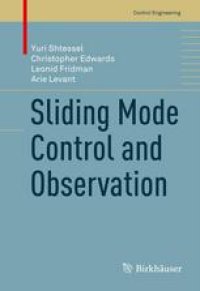
Ebook: Sliding Mode Control and Observation
- Tags: Control Robotics Mechatronics, Vibration Dynamical Systems Control, Systems Theory Control, Appl.Mathematics/Computational Methods of Engineering, Engineering Design
- Series: Control Engineering
- Year: 2014
- Publisher: Birkhäuser Basel
- Edition: 1
- Language: English
- pdf
The sliding mode control methodology has proven effective in dealing with complex dynamical systems affected by disturbances, uncertainties and unmodeled dynamics. Robust control technology based on this methodology has been applied to many real-world problems, especially in the areas of aerospace control, electric power systems, electromechanical systems, and robotics. Sliding Mode Control and Observation represents the first textbook that starts with classical sliding mode control techniques and progresses toward newly developed higher-order sliding mode control and observation algorithms and their applications.
The present volume addresses a range of sliding mode control issues, including:
*Conventional sliding mode controller and observer design
*Second-order sliding mode controllers and differentiators
*Frequency domain analysis of conventional and second-order sliding mode controllers
*Higher-order sliding mode controllers and differentiators
*Higher-order sliding mode observers
*Sliding mode disturbance observer based control
*Numerous applications, including reusable launch vehicle and satellite formation control, blood glucose regulation, and car steering control are used as case studies
Sliding Mode Control and Observation is aimed at graduate students with a basic knowledge of classical control theory and some knowledge of state-space methods and nonlinear systems, while being of interest to a wider audience of graduate students in electrical/mechanical/aerospace engineering and applied mathematics, as well as researchers in electrical, computer, chemical, civil, mechanical, aeronautical, and industrial engineering, applied mathematicians, control engineers, and physicists. Sliding Mode Control and Observation provides the necessary tools for graduate students, researchers and engineers to robustly control complex and uncertain nonlinear dynamical systems. Exercises provided at the end of each chapter make this an ideal text for an advanced course taught in control theory.
The sliding mode control methodology has proven effective in dealing with complex dynamical systems affected by disturbances, uncertainties and unmodeled dynamics. Robust control technology based on this methodology has been applied to many real-world problems, especially in the areas of aerospace control, electric power systems, electromechanical systems, and robotics. Sliding Mode Control and Observation represents the first textbook that starts with classical sliding mode control techniques and progresses toward newly developed higher-order sliding mode control and observation algorithms and their applications.
The present volume addresses a range of sliding mode control issues, including:
*Conventional sliding mode controller and observer design
*Second-order sliding mode controllers and differentiators
*Frequency domain analysis of conventional and second-order sliding mode controllers
*Higher-order sliding mode controllers and differentiators
*Higher-order sliding mode observers
*Sliding mode disturbance observer based control
*Numerous applications, including reusable launch vehicle and satellite formation control, blood glucose regulation, and car steering control are used as case studies
Sliding Mode Control and Observation is aimed at graduate students with a basic knowledge of classical control theory and some knowledge of state-space methods and nonlinear systems, while being of interest to a wider audience of graduate students in electrical/mechanical/aerospace engineering and applied mathematics, as well as researchers in electrical, computer, chemical, civil, mechanical, aeronautical, and industrial engineering, applied mathematicians, control engineers, and physicists. Sliding Mode Control and Observation provides the necessary tools for graduate students, researchers and engineers to robustly control complex and uncertain nonlinear dynamical systems. Exercises provided at the end of each chapter make this an ideal text for an advanced course taught in control theory.
The sliding mode control methodology has proven effective in dealing with complex dynamical systems affected by disturbances, uncertainties and unmodeled dynamics. Robust control technology based on this methodology has been applied to many real-world problems, especially in the areas of aerospace control, electric power systems, electromechanical systems, and robotics. Sliding Mode Control and Observation represents the first textbook that starts with classical sliding mode control techniques and progresses toward newly developed higher-order sliding mode control and observation algorithms and their applications.
The present volume addresses a range of sliding mode control issues, including:
*Conventional sliding mode controller and observer design
*Second-order sliding mode controllers and differentiators
*Frequency domain analysis of conventional and second-order sliding mode controllers
*Higher-order sliding mode controllers and differentiators
*Higher-order sliding mode observers
*Sliding mode disturbance observer based control
*Numerous applications, including reusable launch vehicle and satellite formation control, blood glucose regulation, and car steering control are used as case studies
Sliding Mode Control and Observation is aimed at graduate students with a basic knowledge of classical control theory and some knowledge of state-space methods and nonlinear systems, while being of interest to a wider audience of graduate students in electrical/mechanical/aerospace engineering and applied mathematics, as well as researchers in electrical, computer, chemical, civil, mechanical, aeronautical, and industrial engineering, applied mathematicians, control engineers, and physicists. Sliding Mode Control and Observation provides the necessary tools for graduate students, researchers and engineers to robustly control complex and uncertain nonlinear dynamical systems. Exercises provided at the end of each chapter make this an ideal text for an advanced course taught in control theory.
Content:
Front Matter....Pages i-xvii
Introduction: Intuitive Theory of Sliding Mode Control....Pages 1-42
Conventional Sliding Modes....Pages 43-104
Conventional Sliding Mode Observers....Pages 105-141
Second-Order Sliding Mode Controllers and Differentiators....Pages 143-182
Analysis of Sliding Mode Controllers in the Frequency Domain....Pages 183-211
Higher-Order Sliding Mode Controllers and Differentiators....Pages 213-249
Observation and Identification via HOSM Observers....Pages 251-290
Disturbance Observer Based Control: Aerospace Applications....Pages 291-320
Back Matter....Pages 321-356